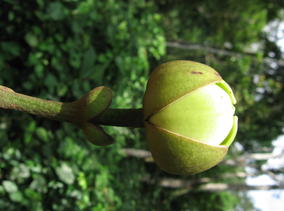You are here
African Annonaceae
Anonidium Engl. & Diels
SUMMARY
Medium-sized to large trees ranging from 8-35 cm tall and up to 80 cm in diameter or shrubs up to 7 m tall. Stem straight, generally smooth, and bark light-green dotted with white spots. Young branches black, pubescent with an indumentum of simple hairs quickly becoming glabrous. Leaves with petiole ranging from 3-15 mm long and 2-7 mm wide, sparsely to densely hairy when young, but soon becoming glabrous. Leaves generally brown, light-green or blackish on herbarium specimens; leaf-texture subcoriaceous to coriaceous (ca. 20-150 μm thick), but thin and papyraceous when young. Leaf-laminas obovate-oblong, elliptic-oblong, oblong, elliptic or lanceolate; leaf-base attenuate or rounded subcordate to attenuate obtuse; leaf-apex attenuate acuminate or rounded, abruptly acuminate. Leaf-lamina adaxial surface glabrous, abaxial surface sparsely puberulous to pubescent with erect or appressed hairs, or entirely glabrous. Lamina margins entirely glabrous. Venation brochidodromous, midrib (and to a lesser extent, the secondary veins) generally distinct, impressed adaxially and prominent abaxially; midrib generally hairy abaxially especially in younger leaves. Secondary veins 7-20 pairs. Secondary veins arcuately ascending, with an acute angle of divergence from the midrib; tertiary venation reticulate or parallel. Smallest distance between loops and the leaf margin 1-4 mm. Inflorescences thyrsoid, terminal, extra-axillary or grouped by 2-3, borne on trunk or older branches, in simple uniflorous or pluriflorous cymes, up to 3-4 m long, ferruginous puberulous to pubescent; each inflorescence consisting of one or numerous flowers. The structure of each inflorescence is a terminal thyrsoid. Each inflorescence consists of a terminal flower with a variable number. Lower bracts coriaceous, sessile or subsessile, triangular-ovate or lanceolate, orbicular and amplexicaul, densely puberulous to pubescent under, glabrous above. Upper bracts one or two, simple or bilobed, ovate, amplexicaul, or semi-amplexicaul. Flower buds are subglobose. Sepals 3, in 1 whorl, valvate, connate basally, shorter than the petals, brown to yellow (in vivo). Petals six, in two whorls of three, valvate; inner petals somewhat smaller than the outer petals, and valvate. Stamens in male flowers numerous, sessile to subsessile, oblong, linear or cuneiform, free, closely packed together, and cover the entire receptacle; thecae linear, extrorse; connective with an enlarged disc-like prolongation, truncate dilated on top of the anthers and puberulent; filaments very short. Stamens in hermaphrodite flowers disposed in 3-5 (sometimes < 2) rows at the base of the receptacle. Carpels numerous with one basal ovule, cylindrical, free, closely packed together, immersed in the receptacle; style short and thick, enlarged above; stigma subglobose. Fruit large, syncarpous, fleshy, indehiscent, subcylindrical to ovate-globose, reticulate; Seeds numerous, vertically arranged, one per mericarp, ovate or oblong, up to 5.5 cm. long.






